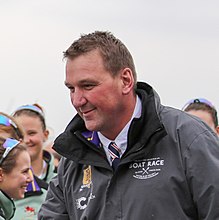The Boat Race 1993
[10][11][12] He caused controversy by instigating a new starting method whereby he would hold the crews for up to ten seconds between the conventional "set" and "go" commands.
[14] Both Alan Inns, former coach and advisor to Cambridge, and Steve Royle, Oxford's director of rowing, expressed concerns over Evans' methodology.
"[17] In contrast, an editorial in The Times claimed: "The performers are no longer ingenuous native undergraduates but supercharged, international, professional rowing machines.
[15] Oxford's Royle noted that Buxton's form had declined in the run-in to the race, while Benham was "handling the pressure a lot better.
[16] Schuller had arrived at Oxford just two months earlier,[22] but rejected suggestions that his late inclusion was symptomatic of the recent influx of "professionals" to the race.
Of his selection, he noted: "You can't have one of the most respected races in the world and then limit it to English people between the ages of 19 and 21 ... on the day we went for whoever would make the boat go fastest.
"[16] Schuller's compatriot and opponent Dirk Bangert had struggled with the move to cleavers, finding it difficult to adjust his timing: "I nearly didn't make it.
"[23] Oxford's finishing coach was Mike Spracklen who had assisted the Dark Blues in five victorious races, while Cambridge had New Zealander Harry Mahon in charge for the first time,[24] assisted by John Wilson (who had helped coach Oxford to a win in the 1991 race),[22] and Sean Bowden,[23] who was subsequently credited with "being half of the team which first turned Cambridge round".
[28] Two minutes after the start, and in cold, overcast conditions,[29] Cambridge's cox Martin Haycock was level with Oxford's Jo Michels who occupied the number two seat in the Dark Blue boat.
Responding to a call to push on, Cambridge were clear upon reaching the Mile Post in record time, and moved in front of Oxford.
"[28] The Oxford Boat Club president Pinsent conceded: "They put right a lot of mistakes they have made in the past, and they rowed outstandingly well.
[23] Writing in The Independent, the journalist Chris Arnot noted that the Cambridge crew had used creatine supplements in order to attempt to enhance their performance.
Used extensively at the 1992 Olympics, by athletes including Linford Christie and Sally Gunnell,[31] and given to horses and greyhounds, creatine was believed to provide legal energy-enhancing effects to the crew.


